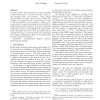Free Online Productivity Tools
i2Speak
i2Symbol
i2OCR
iTex2Img
iWeb2Print
iWeb2Shot
i2Type
iPdf2Split
iPdf2Merge
i2Bopomofo
i2Arabic
i2Style
i2Image
i2PDF
iLatex2Rtf
Sci2ools
SDM
2010
SIAM
2010
SIAM
Reconstructing Randomized Social Networks
In social networks, nodes correspond to entities and edges to links between them. In most of the cases, nodes are also associated with a set of features. Noise, missing values or efforts to preserve privacy in the network may transform the original network G and its feature vectors F. This transformation can be modeled as a randomization method. Here, we address the problem of reconstructing the original network and set of features given their randomized counterparts G and F and knowledge of the randomization model. We identify the cases in which the original network G and feature vectors F can be reconstructed in polynomial time. Finally, we illustrate the efficacy of our methods using both generated and real datasets.
| Added | 29 Oct 2010 |
| Updated | 29 Oct 2010 |
| Type | Conference |
| Year | 2010 |
| Where | SDM |
| Authors | Niko Vuokko, Evimaria Terzi |
Comments (0)

